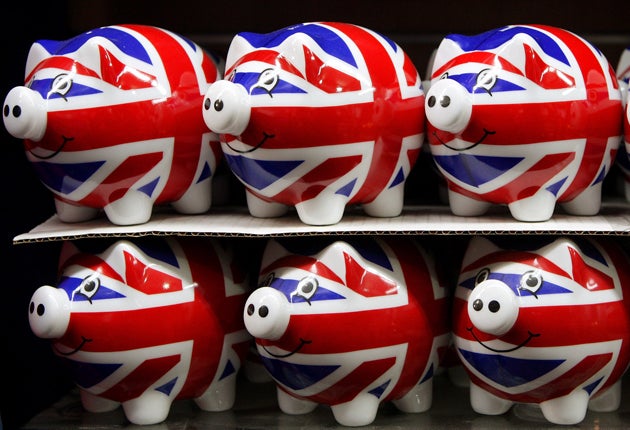Cash ISAs offer glimmer of hope for suffering savers
Interest rates are low, but tax-efficient savings can still be made. Maryrose Fison reports

Your support helps us to tell the story
From reproductive rights to climate change to Big Tech, The Independent is on the ground when the story is developing. Whether it's investigating the financials of Elon Musk's pro-Trump PAC or producing our latest documentary, 'The A Word', which shines a light on the American women fighting for reproductive rights, we know how important it is to parse out the facts from the messaging.
At such a critical moment in US history, we need reporters on the ground. Your donation allows us to keep sending journalists to speak to both sides of the story.
The Independent is trusted by Americans across the entire political spectrum. And unlike many other quality news outlets, we choose not to lock Americans out of our reporting and analysis with paywalls. We believe quality journalism should be available to everyone, paid for by those who can afford it.
Your support makes all the difference.Everyone knows this is not a good time to be a saver.
According to financial information service Moneyfacts, the average deposit account is paying only 0.54 per cent. At that rate, it would take more than a century to turn £1,000 into £2,000; it's unlikely you will be able to wait that long. Against this backdrop of low rates, inflation is stubbornly high with the retail price index currently standing at 4.8 per cent. The consumer price index, which excludes housing costs, stands at 3.1 per cent. That's more than a percentage point above the Bank of England's own target which it is now expected not to meet until 2012.
So how do you make the most of your savings? Several options could put some wind into your saving sails. Instant access (sometimes called "easy access") cash ISAs are the safest, most tax-efficient option out there. But if you feel able to tie up your money for a few years, a fixed rate ISA or a short-term bond will usually offer a higher rate.
Nick Platt, the director of Henwood Court Financial Planning, says there is much to be gained from using an ISA allowance over a regular savings account. "With the annual cash ISA allowance recently increased to £5,100 this year, it takes only 10 years to put more than £50,000 into an ISA which, assuming a return of 3 per cent, will mean that £1,500 will be free of tax and not taken into account as the person's income," he says.
One such example is the flexible cash ISA from Santander and Alliance & Leicester. It's available to all adults aged 16 or above and pays a minimum of 3.2 per cent for one year. It is guaranteed to be at least 2.7 per cent above the base rate at all times. The minimum deposit is £1 and cash can be withdrawn at any point without fear of penalties. The only downside is the product is available only to current account customers of Santander or Alliance & Leicester.
However, not all banks and building societies offer deals exclusively to their own customers. Principality Building Society and Birmingham Midshires offer competitive products for both customers and non-customers. Principality's e-ISA, for example, has a 2.8 per cent variable rate, including a 1 per cent bonus for 12 months with a minimum deposit of £1. Birmingham Midshires' ISA Extra has a 2.7 per cent variable rate, including a 1 per cent bonus for 15 months and a minimum deposit requirement of £500.
But while the flexibility of withdrawals can give peace of mind, higher rates are on offer for those prepared to lock in their money for a bit longer. Take Halifax's fixed rate ISA saver, for example. For a minimum deposit of £500, it offers 4.25 per cent when money is locked in for four years, 3.35 per cent when locked in for three and 3 per cent over two years. Nationwide's one-year fixed rate ISA, by contrast, offers 2.5 per cent and has a minimum investment of £1.
If you've reached your cash ISA limit, there are attractive-looking interest rates to be had on bonds. However, it is worth remembering that, unlike ISAs, growth on bonds does get taxed and penalties for early withdrawals can be high.
Mr Platt says the key is finding a bond that will remain competitive for the duration of its term. "Provided investors can afford to tie up mony for a period of time, it is worth considering a one- to two-year term as the rate on interest is better than the instant access alternatives," he says. "We would not advise a term longer than this because if interest rates increase as predicted, then you could find you are locked into a bond that is yielding an uncompetitive rate of return."
On offer at the moment is ICICI's one-year HiSAVE fixed rate account paying 3 per cent requiring a minimum investment of £1,000. Santander is also offering a 15-month fixed rate bond with 3 per cent for investments over £1 and NatWest's one-year fixed rate bond pays 3 per cent on investments worth £50,000 or more.
The best medium-term bond on offer at the moment is from Lloyds three-year fixed rate bond which offers 3.75 per cent on investments worth £2,000 or more. And ICICI's three-year fixed-rate Super Saver bond earns 3.6 per cent on investments of at least £1,000.
Join our commenting forum
Join thought-provoking conversations, follow other Independent readers and see their replies
Comments